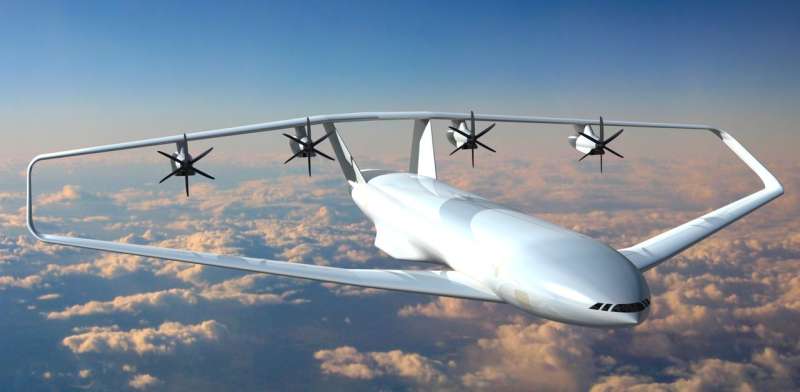Radical closed-wing aircraft design could see greener skies take flight

Aviation is one of the most environmentally harmful forms of transportation, accounting for 3% of all EU greenhouse gas emissions. But new aircraft designs inspired by the work of an early 20th-century aviation engineer and natural substances such as honeycomb and grass could help to cut the environmental footprint of flying.
With nearly 1 billion passengers taking to European skies in 2016 and the numbers still increasing, the growth in European aviation has been staggering. The effect is that even as many other industries are reducing greenhouse gas emissions through efficiency and new technology, aviation's are on the increase.
One person flying from London to New York and back generates roughly the same level of emissions as one year's home heating for the average European. At the recent Transport Research Arena conference in Vienna, Austria, a high-level event covering all modes of European transport, Professor Hans Joachim Schellnhuber, director of the Potsdam Institute for Climate Impact Research in Germany, said avoiding air travel completely was the best option for protecting the environment.
But as Sergio Barbarino, chairman of the Alliance for Logistics Innovation through Collaboration in Europe (ALICE) responded, that's an unlikely scenario. "We can't just tell people they can't take their holidays in the Canary Islands anymore," he said.
Air travel may be here to stay, but there's no doubt that engineers need to find new ways to make it cleaner and greener. One idea is to radically redesign an aircraft's wing so that it requires significantly less operational fuel, an approach that's currently under development by a project called PARSIFAL.
Father of aerodynamics
For their design, the team sought inspiration from the renowned German aviation engineer Ludwig Prandtl, often considered the father of aerodynamics. In 1924, Prandtl had an idea for a plane with an unusual wing that reduced the drag coefficient and improved the aerodynamic efficiency but the idea was largely ignored at the time.
In the late 1990s, Professor Aldo Frediani of the University of Pisa, Italy, and coordinator of the PARSIFAL project, used mathematics to prove that Prandtl's wing theory was plausible. Prof. Frediani and his team began to work on the design of a new closed-wing airplane based on Prandtl's original concept.
"The theoretical results can be used to define a new configuration, our configuration," he said.
Instead of two separate wings extending either side of the fuselage, our familiar concept of an airplane, the Prandtl-inspired aircraft has one wing which loops and closes back on itself in a closed-wing design with no wingtips. This reduces the amount of drag acting on the aircraft, meaning that less fuel is burned. This is especially important for take-off and landing, as these are the phases of airplane flight that usually guzzle the most fuel and expel most emissions.
"These aircraft will be much more convenient from the point of view of fuel consumption, noise pollution and emissions," said Prof. Frediani.
The team has developed a small model of their plane but the idea is to focus on medium-sized aircraft, with the goal of increasing the number of passengers being transported per flight from around 180 to 310. The researchers estimate that the plane could be in the air in 10-15 years' time, depending on safety checks and the interest of aircraft manufacturers. Their next steps are to refine the aerodynamics, engine position and controls, while the University of Pisa's economics department is working with PARSIFAL to determine the projected economic performance of the aircraft.
"This solution could completely change the air transport of the future," said Prof. Frediani.
Meanwhile, other engineers are taking inspiration from nature to develop 3-D printed aircraft components that could reduce weight by up to 30%. The less a plane weighs, the less fuel is required, resulting in a significant reduction of CO2 emissions.
Honeycomb structure
Melanie Gralow is a biomimetic design engineer for the Bionic Aircraft project, which is taking the lessons of nature to improve parts for making aeroplanes.
"Thin surfaces or rods tend to deform very easily throughout the manufacturing process," she explained. "You can stiffen them by applying a certain surface structure. The honeycomb structure is one of those bio-inspired structures that can be utilised to stiffen the wall without adding too much weight."
The project also takes inspiration from grass stalks, which are subject to bending loads by the wind in the same way as struts in aircraft components. Bending loads are forces that act upon a structure laterally and hence can result in it bending.
"The stalk is hollow inside and it has a double wall system," said Gralow. "It needs to resist wind forces in nature, but struts in the technical world also have to resist bending. By applying the double-walled system to the struts, we can make them more lightweight, but at the same time just as stiff as they need to be."
To make these intricate, highly-detailed, lightweight parts, the team uses 3-D printers with laser beam technology. Although ideal for small precision work, the researchers say that printing an entire aircraft in this way is still a long way off.
"For now, the goal is really to focus on smaller parts because the build spaces of the current printers are restricted. The biggest commercial printers are about 40—50 centimetres in width, so that sets the maximum size limit for current 3-D-printed metal parts," said Gralow.
Provided by Horizon: The EU Research & Innovation Magazine





















